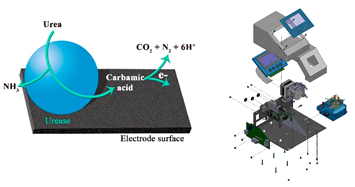|
JULIJA RAZUMIENĖ
|
|
Electrochemical Biosensors for Real-World Applications
Biosensors are handy devices, which can rapidly detect and measure a variety of specific compounds. Those devices can significantly improve the quality of life for patients suffering from a variety of diseases by helping the medical personnel to diagnose diseases faster and more accurately as well as help to evaluate other significant factors. However, to develop a biosensor operating with adequate performance for real-world applications is a tedious task. Real media samples are complex, making an accurate detection difficult. For example, human blood, the most clinically relevant sample, is composed of thousands of different compounds with unique properties, a variety of blood cells and countless number of proteins. To discern a single type molecule from this entire composition, a biosensor should be specifically designed and engineered. Typically, the surface of the electrochemical biosensor is covered with compound-specific enzyme, unique membranes are designed to reject the interfering compounds, complex electronics and mathematical analysis models are used to increase the signal-to-noise ratio. Our department designs such biosensors capable of analysing various peculiar media obtained from nature. The significance of some of analytes we are interested in are not yet realized, e.g. glutamate concentration in mice brain media or release of glucose as a stress factor in fish tanks.
Our department has been working with the development of biosensors for real-world applications involving devices for clinical practice, accumulating sizeable competencies in this field. In recent works, we have demonstrated a new type ofnanomaterial-based glucose biosensors, which could operate with high precision and accuracy in clinically-relevant fluids – human serum [1] and blood [3]. This type of biosensors could be miniaturized and implanted in patients’ bodies and be used for real-time monitoring of glucose. Additionally, we have developed biosensors for low-level glucose measurements and demonstrated that those biosensors could be used for monitoring the stress level of juvenile trout fish [2]. Clinically relevant projects in our department are carried out in cooperation with Vilnius University Hospital Santaros Klinikos and are related to the diagnosis and prognosis of the clinical outcome of patients undergoing renal replacement therapy as well as of those with other specific conditions, e.g. acute pancreatitis [4].
SELECTED PUBLICATIONS
1. Ratautas, D.et al. Real-time glucose monitoring system containing enzymatic sensor and enzymatic reference electrodes. Biosensors & Bioelectronics. 2020, 164: 112338.
2. Makaras, T., Razumienė, J. et al. A new approach of stress evaluation in fish using β-d-Glucose measurement in fish holding-water. Ecological Indicators. 2020, 109: 105829.
3. Gineitytė, J. et al. Highly efficient direct electron transfer bioanode containing glucose dehydrogenase operating in human blood. Journal of Power Sources. 2019, 441: 227163.
4. Razumienė, J. et al. The synergy of thermally reduced graphene oxide in amperometric urea biosensor: application for medical technologies. Sensors. 2020, 20: 4496.
Amino Acids’ Biosensor in Clinical Applications
We are developing an electrochemical biosensor platform for the fast, accurate and cheap detection as well as quantification of total and specific (glutamate, glutamine, lysine) amino acids present in biologically relevant fluids – dialysate buffer after haemodialysis and human serum/blood. The analysis of the amino acids in biological fluids for clinical applications is an unresolved challenge worldwide, since the concentration levels of amino acids are very low (typically 1–100 µmol/l or less) and create challenges. The major applicable methods for amino acid analysis in clinical diagnostics involve either commercial colorimetric (e.g., ELISA) kits or chromatographic amino acid analysers, which are costly, time-consuming and require highly trained scientific personnel to operate. For such reasons the analysis of amino acid in hospitals for clinical diagnostics and monitoring is not a usual routine procedure. Consequently, the extreme diagnostic potential of amino acids present in biological fluids is not fully utilized and may be overlooked (RCL grant No. 01.2.2-LMT-K-718-03-0005 and S-EJPRD-20-1).

Biosensors for Fish Stress Level Control
Recently, our long-lasting glucose biosensor technology has been upgraded for measuring nanomolar concentrations of glucose in fish tanks. This has been proven statistically relevant in determining levels of stress experienced by rainbow trout juveniles [2]. The developed biosensor has several advantages over conventional methods, i.e. a wide linear range, high sensitivity, good selectivity, long-term stability and ability to act in non-pre-treated turbid media. In future, glucose measurement in water using an appropriate biosensor could be a useful tool for assessing environmental risk for assessing different contaminant exposure and effects (RCL grant No. 09.3.3-LMT-K-712-19-0110).

Urea Biosensors with Thermally Reduced Graphene Oxide
We discovered that the synergy of the electrode based on thermally reduced graphene oxide (TRGO) nanoparticles in combination with urease allowed the development of a promising urea biosensor for clinical trials. According to the data of recently reported (2015–2019) urea biosensors, the features of TRGO-based urea biosensor include advanced analytical characteristics such as good sensitivity, wide linear range, long storage and operational stability for the accomplishment of more than 300 samples of clinical trials without significant change. Low-cost design, good reproducibility and fast response time allowed applying the biosensor for monitoring of urea levels in real samples such as urine, blood and dialysate collected during the haemodialysis (HD) procedure. The accuracy of the biosensor action was validated by approved methods on a base of a large number of measurements.
The experiments confirmed that urea measurement in urine and in spent dialysate possess a great potential as a tool for evaluation of dialysis adequacy as well as a step leading to point-of-care non-invasive technologies (RCL grant No. 01.2.2-LMT-K-718-01-0025).



